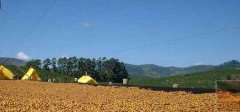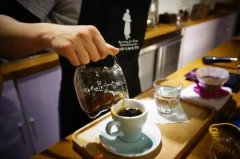The cultivation of Colombian Coffee Manor in-depth understanding of Colombian Coffee
Professional barista communication, please pay attention to coffee workshop (Weixin Official Accounts cafe_style)
Coffee cultivation in Colombia
Columbian coffee cultivation is distributed along the Andes Mountains, from south to north, roughly divided into northern production areas (green), central production areas (orange, purple) and southern production areas (yellow), of which orange purple areas have two primary and secondary production seasons, green and yellow areas have a production season.
Harvest season [varies by region]
Due to the geographical and climatic differences from north to south, the north and south production seasons are just opposite, while the central part has different primary and secondary production seasons according to the south or north. It can be said that beans are produced all the year round. We mainly distinguish the regions according to the winter production season and summer production season. The winter production season is from September to December, including the following regions:
Magdalena Magdalena Common Items
Santander Santander
Antioquia Antioquia
North of Santander Norte de Santander
Boyaca Boyaca
Meta Tower
In the central and northern regions, there will be two main and secondary production seasons. The main production season is from September to December in winter, and the second production season is from April to May in summer.
Caldas
Risaralada
Cundinamarca part of the region began to emerge in the market
Quinido Gold Dior parts of the region began to emerge in the market
Tolima Part of the region Sub-ashes Common items
In the central and southern regions, there will be two primary and secondary production seasons. The primary production season is from March to June in summer, and the secondary production season is from October to November in winter.
Part of Valle Vaille begins to emerge on the market
Quindio Quindio Parts
Cundinamarca Some areas of Cundinamarca
Tolima Part of Tolima
Summer season from March to June, including the region has
Part of Valle Valle
Cauca exam secondary ashes common
Cundinamarca Some areas of Cundinamarca
Huila Huilan ashes common
Narino, exquisite, cremated, common.

Important Notice :
前街咖啡 FrontStreet Coffee has moved to new addredd:
FrontStreet Coffee Address: 315,Donghua East Road,GuangZhou
Tel:020 38364473
- Prev

How coffee beans are treated the difference between sunburn and washing
Communication of professional baristas Please pay attention to the Coffee Workshop (official Wechat account cafe_style) Sun treatment will first identify the sunken beans in the sink, that is, ripe or half-ripe beans will be spread in the drying farm for natural drying. The specific time depends on the local climatic conditions, which usually takes two to four weeks. When the moisture of the coffee bean is reduced to 12%, then use a sheller to grind off the dry and hard.
- Next

The world is too noisy, let's make a good cup of coffee, into their own small universe bar!
Professional barista communication, please pay attention to coffee workshop (Weixin Official Accounts cafe_style) The world is too noisy, lover is too sticky, cat is too cold, work is too heavy, make a good cup of coffee for yourself, enter your own small universe! Step 1. Choosing coffee beans Coffee beans are simply divided into light roast, medium roast and heavy roast. Coffee cherries are actually like fruit, good coffee beans
Related
- Beginners will see the "Coffee pull flower" guide!
- What is the difference between ice blog purified milk and ordinary milk coffee?
- Why is the Philippines the largest producer of crops in Liberia?
- For coffee extraction, should the fine powder be retained?
- How does extracted espresso fill pressed powder? How much strength does it take to press the powder?
- How to make jasmine cold extract coffee? Is the jasmine + latte good?
- Will this little toy really make the coffee taste better? How does Lily Drip affect coffee extraction?
- Will the action of slapping the filter cup also affect coffee extraction?
- What's the difference between powder-to-water ratio and powder-to-liquid ratio?
- What is the Ethiopian local species? What does it have to do with Heirloom native species?

